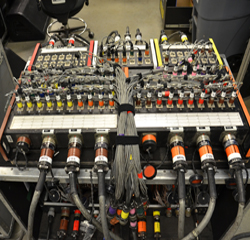A live concert or event often serves a wider audience than those seated in the arena. In addition to the audio in the house and video at the side of the stage, it might also be simulcast to a separate location, streamed on the web, recorded for archival or other purposes, and/or broadcast via radio or television.
To accomplish this task, audio signals from microphones and instruments must be split beyond the traditional front of house and monitor positions and sent to other locations, be they other control rooms at the venue or inside production trucks.
Complicating matters more, these locations will probably be on different legs of the electrical system, potentially adding ground loops and hum to the signal.
With the more widespread adoption of digital consoles and networking in live sound applications, there’s much more potential to access the same signals and be tied together in ring or other topologies with the audio remaining in the digital domain. I was curious whether (and how) these newer technologies are being used.
My search began at the Monterey Jazz Festival, where the main stage shows are simulcast to the Jazz Theatre and other locations onsite as well as often shared via radio or webcast. McCune Audio (San Francisco) handles the audio and video for the festival. I then talked with folks at several major sound companies about how they handle the issues of signal splitting, grounding, and interfacing consoles.
Main Stage Simulcast
The 6,500-seat arena at the Monterey Jazz Festival, where the main acts perform, is the focal point of the simulcast and broadcast activities. DiGiCo SD10 consoles are located at FOH and monitors, with their D-Racks at the side of the stage near the monitor station. Four video cameras are positioned in the house for full-stage shots as well as on either side of the stage for close-ups.

The video and simulcast control center is set up behind and underneath the main stage. All camera shots are called from this location, audio is embedded with the video, simulcast feeds are processed and distributed, and in 2014, the show was also webcast. Archiving is done from a production truck outside the arena, with an Avid VENUE Profile console building its own mix.
This mix is also sent to radio, as it has been every year with the exception of the 2015 edition of the festival. The raw feeds from the onstage cameras are provided to screens at both FOH and the archiving truck so that the engineers have visual information about what’s happening on stage, even during changeovers between acts.















